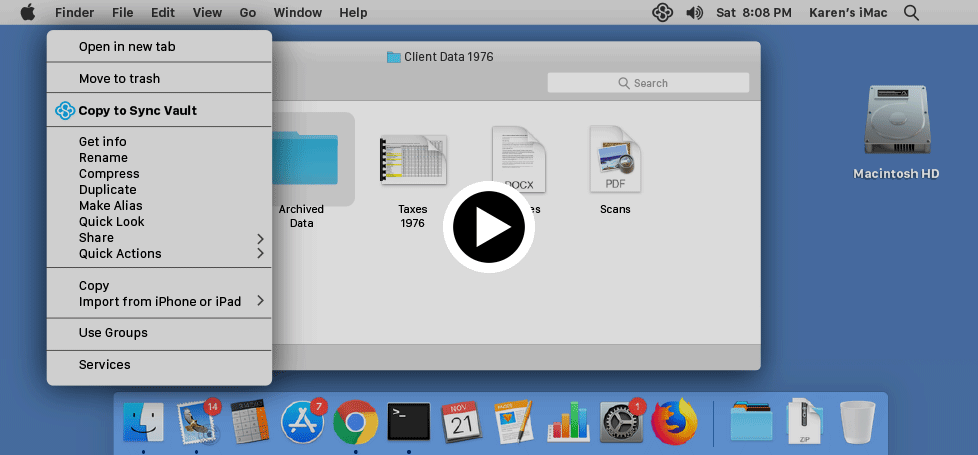What is the Sync Vault?
Your Sync account includes a cloud-only storage space called Vault. Vault is typically used to backup files and folders located outside of your Sync folder. Files stored in Vault are not automatically synchronized to your other computers or devices, which makes it ideal for backups or freeing up space.
In this article:
- What are the differences between the Sync folder, and Vault?
- How do I access and download files and folders stored in Vault?
- How do I upload files and folders to Vault?
- How are files in Vault organized?
- How do I move files from the Sync folder to Vault?
- How do I confirm that a file is stored in Vault?
- How do I use Vault to free up space on my computer, phone or tablet?
What are the differences between the Sync folder, and Vault?
The Sync folder is a special folder located on your computer, that is backed up to the cloud as you add or make changes to your files. Additionally, files in the Sync folder are automatically synchronized to any other computer you install the Sync desktop app on, making it easy to access the same set of files from multiple computers.
Vault is a separate “cloud only” storage location that does not automatically synchronize. You can manually copy any file or folder, anywhere on your computer (including external drives), to Vault, to create a cloud backup.
How do I access and download files and folders stored in Vault?
Files and folders stored in Vault are accessible from the web panel or mobile apps, and can be downloaded from the cloud, back to your computer easily, anytime.
To access files stored in Vault, from the Sync.com web panel:
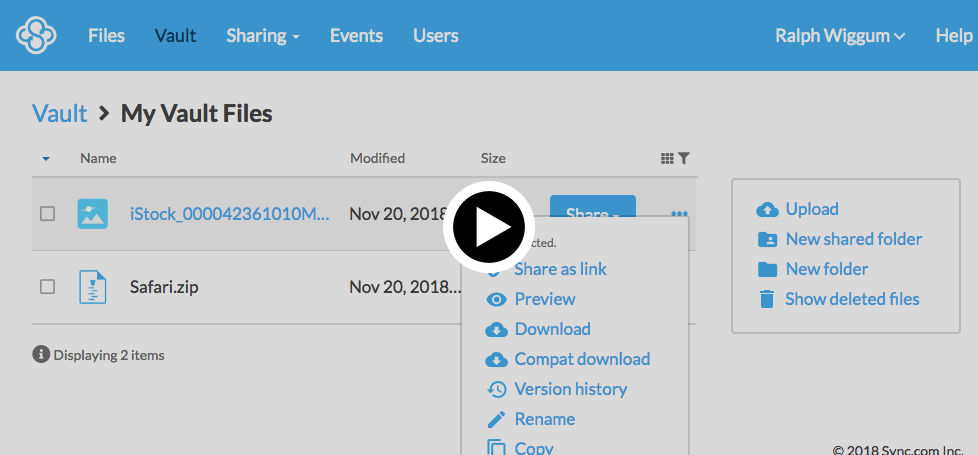
- Sign in to the web panel.
- Click the Vault tab on the top menu bar.
- Click the (ellipsis) icon beside any file to open the file menu.
- Select Preview (if available) to view the file. Select Download to transfer the file back to your computer.
To download everything stored in Vault, back to your computer (all at once):
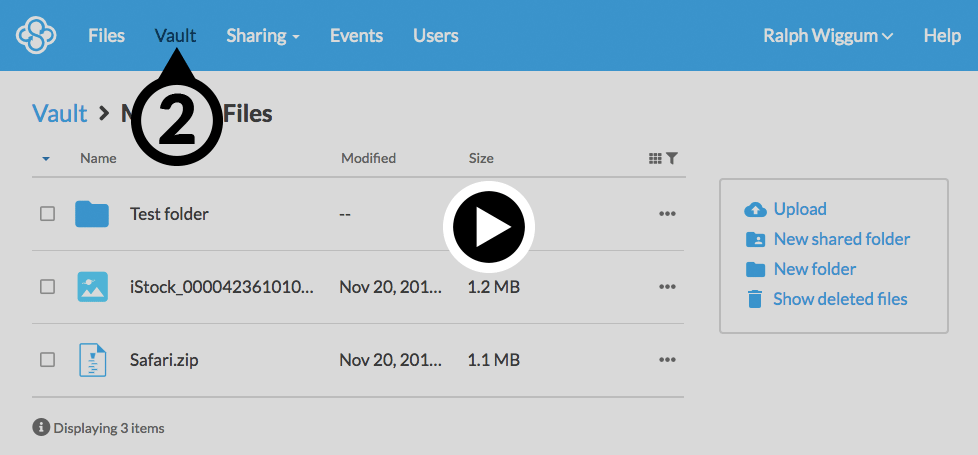
- Sign in to the web panel.
- Click the Vault tab on the top menu bar.
- Select multiple files and folders by checking them , or selecting all from the dropdown arrow at the top left corner of the file listing.
- Select Copy from the file menu.
- Check the Sync folder checkbox.
- Click Copy.
The files you selected will then be copied to the Sync folder, and automatically downloaded to your computer if you have the Sync desktop app installed.
To access files stored in Vault, from your phone or tablet:
- Install the Sync mobile app on your mobile device.
- Open the Sync mobile app.
- On iOS tap the Vault icon on the bottom menu bar. On Android tap the (menu) icon and select Vault.
- Tap the (ellipsis) icon beside any file to open the file menu.
- Select Open with … from the file menu.
How do I upload files and folders to Vault?
You can upload any file or folder located virtually anywhere on your computer (including external drives), to Vault, to create a cloud-only backup. To do so you will need to install the Sync desktop app.
Upload to Vault from a Windows or Mac computer:
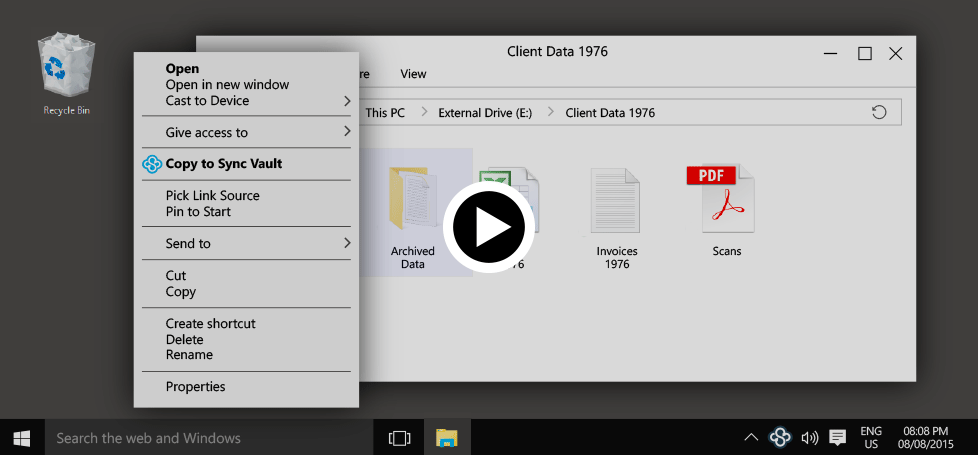
Show on Windows Show on Mac
- Navigate to a file or folder on your computer (outside the Sync folder) using Windows File Explorer or Mac Finder
- Right click on the file or folder
- Select Copy to Sync Vault from the file menu
- At this point the Sync icon in the Windows system tray or Mac menu bar will spin for the duration of the copy. Click the icon to view transfer progress, or to stop the transfer.
Important: Once complete, a transfer report detailing any files that could not be copied will be placed in Vault. To avoid data loss, be sure to review this report. You can upload up to 1 TB at a time.
Upload to Vault using the Sync.com web panel:
- Sign in to the web panel.
- Click the Vault tab on the top menu bar.
- Select Upload from the side menu.
- Click the Choose files button, or drag and drop files or folders directly into the transfer box.
Upload to Vault, from your phone or tablet:
- Install the Sync mobile app on your mobile device.
- Open the Sync mobile app.
- On iOS tap the Vault icon on the bottom menu bar. On Android tap the (menu) icon and select Vault.
- Tap the + (plus) icon to select files to upload.
What happens if I upload a folder or file that has already been uploaded?
Sync will only upload a file if it is new or has been changed. In the case of folders, Sync will scan the entire folder and only upload new or changed files. This saves bandwidth, and makes subsequent Vault transfers faster.
How are files in Vault organized?
Files uploaded to Vault from Windows Explorer or Mac Finder are organized using the full file path. For example, if you uploaded filename.txt from your desktop, it would be saved to Vault under the full path of:
“Device Name/Drive Letter/Full/File/Path/filename.txt”
This prevents data from being overwritten if you upload file or folders with identical names from different locations, or have multiple computers attached.
How do I move files from the Sync folder to Vault?
If you have files in the Sync folder that you no longer need local access to, you can move them into Vault for safe keeping (and to free up space).
Here’s how to move files from the Sync folder to Vault:
- Sign in to the web panel.
- Click the (ellipsis) icon beside any file to open the file menu.
- Select Move.
- Check the Vault checkbox.
- Click Move.
Important: When you move a file from the Sync folder to Vault, it will be deleted from your computer, and stored in the cloud only (until you download it back to your computer).
How do I confirm that a file is stored in Vault?
Sync provides a number of ways to audit confirm what is stored in Vault.
View the Vault transfer report:
When you upload files or folders to Vault directly from your computer, a transfer report detailing any files that could not be copied will be placed in the Vault. To avoid data loss, be sure to review this report, each time you copy something new to the Vault. Here’s how:
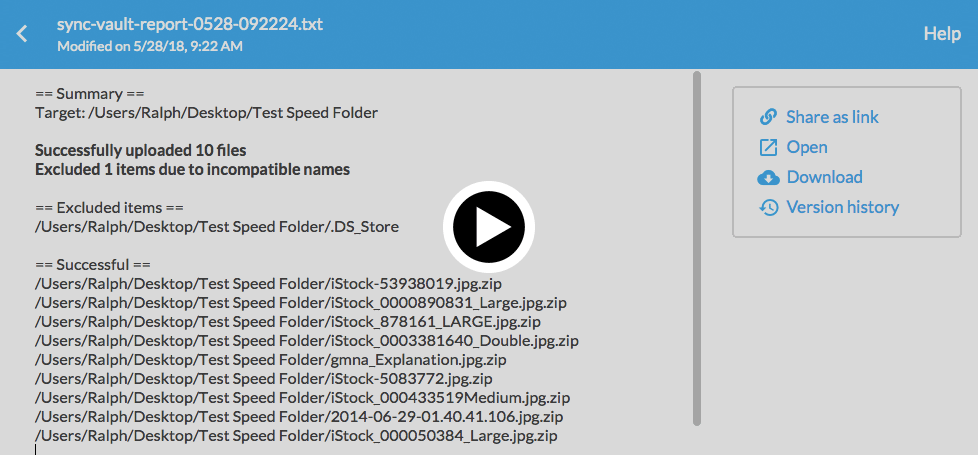
- Sign in to the web panel.
- Click the Vault tab on the top menu bar.
- There will be a separate sync-vault-report-123456.txt file for every Copy to Sync Vault action you have initiated. Click on the report name to view it.
- The report will detail the status of every file copied.
Important: If you do not see a report file, it means the Vault copy did not complete successfully. You should try copying again, or contact support for assistance.
To prevent syncing problems across different operating systems and platforms, a subset of incompatible characters are not supported by Sync. Files named with these characters may be skipped (not uploaded), and will be listed in the Vault report as being skipped. The easiest solution would be to rename the file without these characters, and copying again.
Export full Vault file listing:
If you have the Sync desktop app installed, you can export a full listing of all files stored in Vault, which makes auditing easier. Here’s how:
- Click the Sync icon on the Windows system tray or the Mac menu bar.
- Click the Settings icon (cog).
- Select Preferences.
- Select the Account tab.
- Click Generate beside export, to get a listing of all files.
A .CSV file will download to your computer, which you can open, to search for specific files and verify your files stored in Vault.
View Vault storage quota usage:

Files in the Vault count towards your overall storage quota. View your storage space usage as follows:
- Sign in to the web panel.
- Click your Username on the top menu bar.
- Select Settings.
How do I use Vault to free up space on my computer, phone or tablet?
You can use Vault to free up space by storing files in the cloud-only and removing them from your computer or device. Files and folders stored in Vault are accessible from the web panel or mobile apps, and can be downloaded from the cloud, back to your computer or devices anytime.
Free up space after uploading files or folders to Vault:
- Upload your files or folders to Vault directly from your computer, phone or tablet by following these instructions.
- Confirm that your files uploaded to the Vault successfully by following these instructions.
- Once you have confirmed your files were uploaded to Vault successfully, you can proceed to delete them from your computer, phone or tablet to free up space.
Free up space by moving files from the Sync folder to Vault:
If your files are already in the Sync folder you can move them to Vault and they will automatically be removed from the Sync folder on computers you’ve installed the desktop app on (freeing up space). Move files from your Sync folder to Vault by following these instructions.
